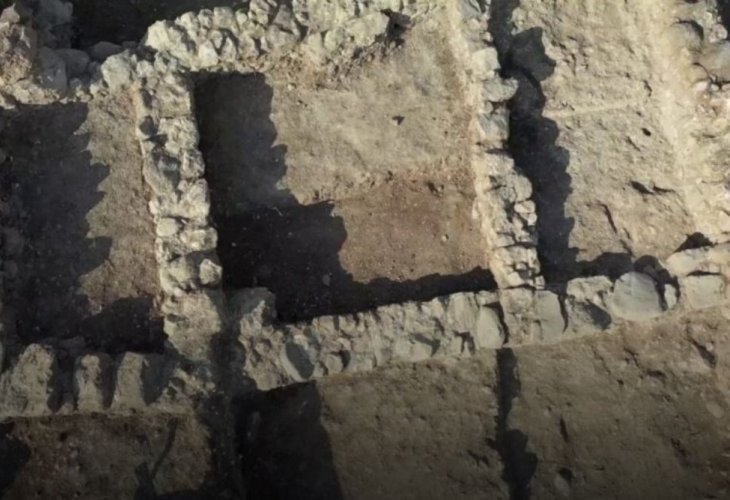Revealing History: Two Ancient Synagogues Unearthed in a Single Galilee Village
A Second Temple-era synagogue has been uncovered in Migdal. Remarkably, it's the second such discovery at this historic site, once a stronghold of Josephus during the Jewish-Roman Wars.
 The historic discovery at Migdal. Photo: University of Haifa
The historic discovery at Migdal. Photo: University of HaifaAn approximately 2,000-year-old synagogue from the Second Temple period has recently been uncovered in Migdal, near the Sea of Galilee. This discovery is significant because it is the second synagogue unearthed in Migdal, dating back to the times when the Temple in Jerusalem was still standing.
Migdal was a large Jewish settlement during the Second Temple period, and after the Temple's destruction, it served as the main base for Josephus in his campaign against the Romans in the Galilee. "The revelation of a second synagogue in this Galilean settlement sheds light on the social and religious life of the Galilean Jews of the time, highlighting their need for a dedicated space for Torah study, prayer, and social gatherings. The synagogue's rich finds, such as clay lamps, glass bowls made in molds, coins, and stone vessels used for purification, indicate the strong ties of Migdal's Jews to Jerusalem and the Temple," said Dina Avshalom-Gorni of the University of Haifa, a co-director of the excavation.
Migdal is located on the northwestern shore of the Sea of Galilee. Over a decade ago, the eastern part of Migdal was excavated by the Israel Antiquities Authority, led by Dina Avshalom-Gorni, where the first synagogue, also from the Second Temple period, was discovered. At the center of this synagogue, a unique stone with a relief of a seven-branched menorah was found, believed by researchers to have been a replica of the Temple menorah. This stone is currently exhibited at the "Beit Yigal Alon" museum in a display called "The Sanhedrin Trail" by the Israel Antiquities Authority.
 The second ancient synagogue in Migdal. Photo: University of Haifa
The second ancient synagogue in Migdal. Photo: University of HaifaThe synagogue recently excavated was initially detected in salvage excavations conducted by the Israel Antiquities Authority at the beginning of the year for Netivei Israel, under the direction of Barak Tzin. The Antiquities Authority pointed to a Roman-era public building, but due to limited excavation, its use was undefined. Continuing rescue excavations have revealed a spacious, square structure made of basalt and limestone, with a central hall and two additional rooms. The central hall's walls were plastered in white and colored plaster, with a stone bench built along them, also plastered. The ceiling, likely made of wood and clay, was supported by six columns, two of which are preserved in situ with stone bases. In a small room on the southern side of the hall, a plastered stone shelf was found, possibly used for scroll storage.
In the 2009 excavation, it was the first synagogue from the Second Temple period discovered in the Galilee—and the ninth throughout the country. Since then, another synagogue from that period has been found in the Galilee, and now a second synagogue in Migdal has been uncovered, marking the first time that two synagogues have been discovered in the same settlement. According to the researchers, this discovery hints at Jewish life during the Second Temple period. "During this time, the Temple was still in existence, hence the rarity of synagogue evidence might suggest it was not a widespread building," said Prof. Adi Erlich, head of the Department of Archaeology at the University of Haifa.
However, the discovery of two synagogues within a village of several thousand residents—and less than 200 meters apart—changes the narrative. "The fact that we found two synagogues indicates that the Jews of the Second Temple period were looking for a place for religious, and perhaps social, gatherings. The finding of the Temple menorah stone in the other Migdal synagogue shows us they indeed saw Jerusalem as the religious center, and local activities occurred influenced by Jerusalem's centrality. The synagogue we are currently excavating is adjacent to a residential street, whereas the 2009 synagogue was surrounded by an industrial area. Thus, local synagogues were integrated into the social fabric of the settlement," added Avshalom-Gorni.
Eli Eskosido, Director of the Israel Antiquities Authority, said: "The significance of the find, first uncovered in the salvage excavation by the Israel Antiquities Authority and currently being fully excavated by the University of Haifa team, is vast. In the coming weeks, we will discuss possibilities to develop the site into a public tourist attraction."

